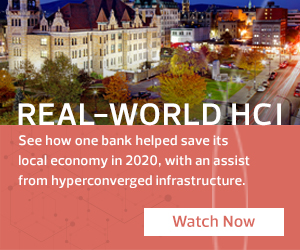How a New Data Center Enabled Remote Work
In December 2019, FNCB upgraded its data center to Lenovo switches and hyperconverged infrastructure powered by Nutanix. Bank officials had no idea that a crisis was looming, but the timing of the upgrade was nevertheless fortuitous. Had it not been for the new data center, the bank’s IT team would have had a much more difficult time moving its staff offsite, says Ronald Honick, senior vice president and technology services officer at FNCB.
“Using the Lenovo and Nutanix solution, we had that ability to let them safely work remotely,” says Honick. “We could not have done that in our old data center.”
Of course, FNCB made the upgrade with the goal of gaining improved performance, greater scalability, simplified management and enhanced disaster recovery capabilities. It received those benefits and then some, says Kirk S. Borchert, a vice president and technology services officer.
“It’s nothing short of fantastic,” he says, noting that the bank’s IT staff has appreciated the simplified management that comes with hyperconverged systems. “Their lives are so much easier maintaining these systems, and the stability is amazing.”
Learn how FNCB was able to continue serving its customers amid disruptions.
Hyperconverged Infrastructure Supports Cost-Effective Growth
Data center upgrades aren’t one-size-fits-all projects, but many of today’s trends, including hyperconverged infrastructure, deliver big returns in terms of agility and scalability, says Laura DiDio, principal of Information Technology Intelligence Consulting.
“It’s important to consider not just what you’re doing now but what your networking is going to look like two years from now,” she says.
Indeed, when Honick and Borchert began plotting out FNCB’s data center strategy, they knew that achieving greater agility was a critical objective. The bank is growing, but predicting growth over long periods of time is difficult. It needed an infrastructure that could support its growth cost-effectively, allowing it to scale up or down as needed. HCI is ideal in such circumstances.
The real-time visibility afforded by FNCB’s new hyperconverged infrastructure was revolutionary. “I don’t need to spend an extra 30 percent up front, and also I’m not going to have a headache later on,” Honick says. “I can see as I’m getting closer to that threshold and can budget and plan in advance.”











